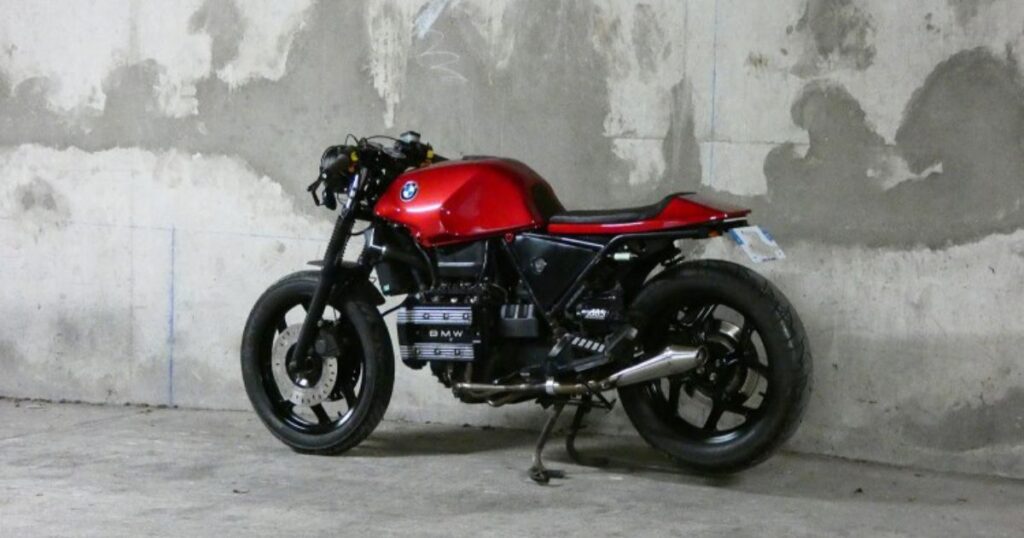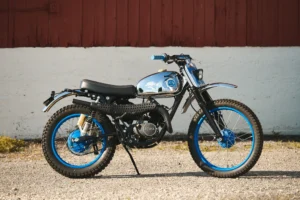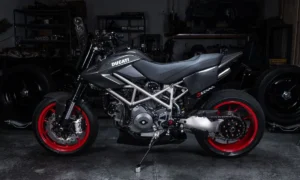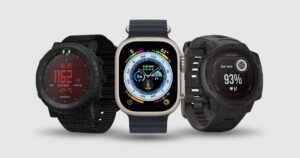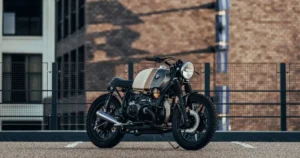Table of Contents
ToggleThe BMW K75 is a popular choice for custom cafe racer builds. It offers a reliable engine, unique design, and solid performance. However, many owners face mechanical issues after modifications. These problems often appear during or after the build process.
This guide explains the five most common BMW K75 cafe racer problems. Each section focuses on one issue and shows how to fix it. You will learn about electrical faults, engine behavior, and handling troubles. All solutions use basic tools and easy steps.
Whether you ride daily or work on weekends, this guide helps keep your K75 smooth and safe. Read carefully. Fix one problem at a time. Use this article to enjoy a more reliable and better-performing cafe racer.
1. Starting Issues After Modifications
Many K75 cafe racer builds face starting problems after electrical or mechanical changes. These issues happen due to altered fuel flow, wiring mistakes, or sensor disconnection.
Fix 1: Check the Fuel System
Start by inspecting the fuel pump. Make sure it primes when you turn the key. Listen for a soft hum from the tank. If silent, test the fuel pump relay and wiring. Clean the fuel filter to avoid blockage. Use only fuel lines rated for injection systems.
Fix 2: Inspect the Ignition Components
Verify spark plug condition. Replace worn or fouled plugs. Check the ignition coil for cracks. Confirm tight connections at the coil and plug wires. Ensure correct spark plug gap based on K75 specifications.
Fix 3: Review the Battery and Starter Circuit
Use a multimeter to measure battery voltage. It must read above 12.4 volts when resting. Inspect ground wires for corrosion. Clean all terminals. Check the starter relay and main fuse under the tank.
Fix 4: Restore the Neutral and Clutch Switches
The bike will not start if the clutch switch or neutral sensor fails. Bypass the clutch switch briefly to test function. Confirm the bike shows a green neutral light before pressing start.
Fix 5: Verify the Kill Switch and Wiring
Make sure the handlebar kill switch is working. Open the housing if needed. Clean contact points. Use contact cleaner spray. Follow the wiring back to the ignition control unit. Look for cuts or melted insulation.
2. Poor Idle or Stalling at Low RPMs
After converting the BMW K75 into a cafe racer, some riders face unstable idle or engine stalling. These problems often happen after intake or exhaust modifications. Changes in airflow disturb the engine’s balance at low speeds.
Fix 1: Adjust the Air-Fuel Mixture
Start by inspecting the throttle body air screws. Turn each screw slightly to fine-tune the idle. Keep the idle speed close to the factory range. If unsure, refer to the K75 service manual for correct settings.
Fix 2: Look for Vacuum Leaks
Old vacuum hoses often crack during a rebuild. Spray carb cleaner around intake boots and vacuum lines while the engine idles. If the idle changes, there is a leak. Replace worn hoses with fresh, tight-fitting ones.
Fix 3: Sync the Throttle Bodies
Uneven throttle operation causes shaking or stalling. Use a basic vacuum gauge to sync all three throttle bodies. This balances air intake between cylinders and improves idle quality.
Fix 4: Clean the Idle Control Valve
Remove the idle valve under the airbox. Use carb cleaner to clear dust and oil buildup. A sticking valve will prevent proper airflow at idle. Reinstall and test idle performance.
Fix 5: Inspect Fuel Injector Spray
If one cylinder runs lean, it may stall the engine. Remove the fuel injectors. Test spray pattern and volume. Clean or replace clogged injectors. Proper spray ensures smooth idle under all conditions.
3. Electrical Gremlins After Stripping the Harness
Custom cafe racer builds often remove or shorten the original wiring harness. This creates a cleaner look but can cause many electrical problems. Signals may fail. The starter may not work. Lights may flicker. These problems happen when wires are cut or re-routed without proper planning.
Fix 1: Check All Grounds
Bad ground connections are a common issue. Locate all ground wires on the frame and engine. Remove the bolts. Clean the contact surfaces with sandpaper. Reattach the wires tightly. Apply dielectric grease to prevent rust.
Fix 2: Inspect Soldered and Crimped Connections
Loose joints create poor contact. Tug gently on each wire to check for weak spots. Use heat-shrink tubing on every connection. Avoid electrical tape. It peels over time and collects moisture.
Fix 3: Test for Broken or Pinched Wires
Trace every wire from the battery to the lights, starter, and ignition. Look for sharp bends or places where wires rub against metal. Replace damaged wires with the correct gauge and color.
Fix 4: Use a Simple Wiring Diagram
Many riders remove the factory fuse box and relays. This causes confusion later. Build a custom diagram with labels. Include each circuit: ignition, starter, charging, and lights. Keep a printed copy near your tools.
Fix 5: Protect and Organize the Wiring
Use wire loom or heat wrap to group wires. Secure them with clips or zip ties. Keep wires away from the engine and exhaust. High heat will melt insulation and cause failure.
4. Overheating in City or Low-Speed Riding
The BMW K75 uses a liquid-cooled engine. It needs constant airflow to stay within a safe temperature range. During slow riding or traffic, many cafe racer builds experience overheating. This risk increases when parts like the radiator or fan system are relocated or modified.
Fix 1: Inspect the Radiator for Blockage
Remove any debris stuck in the radiator fins. Dirt, bugs, or paint can block airflow. Clean gently with low-pressure water. Use a soft brush if needed. Make sure the radiator is not bent or damaged.
Fix 2: Test the Cooling Fan Operation
Turn on the ignition. Let the engine run until hot. The fan should start before the temperature warning light comes on. If not, test the fan motor, fuse, and fan relay. Replace faulty parts.
Fix 3: Check the Thermostat and Housing
A stuck thermostat prevents coolant flow. Remove and place it in hot water. It should open at the correct temperature. Replace if it stays closed. Clean the housing and install a new gasket if needed.
Fix 4: Flush and Refill the Coolant System
Old coolant loses its ability to cool the engine. Drain all fluid. Use a mix of distilled water and approved coolant. Avoid tap water. Refill slowly to prevent air pockets. Bleed the system by running the engine with the cap off.
Fix 5: Review Radiator Placement and Airflow
On many cafe builds, the radiator gets covered or moved. Make sure it receives enough air while riding. Avoid blocking it with custom body panels. Install airflow guides or vents if needed.
5. Vibration or Handling Issues Post-Conversion
After converting the BMW K75 into a cafe racer, some riders feel new vibrations or poor handling. These problems are often caused by custom parts that change the bike’s balance. Frame adjustments, seat height, or suspension changes can affect how the bike rides and responds.
Fix 1: Inspect Wheel Alignment
Misaligned wheels cause unstable steering. Place the bike on a flat surface. Use a straight edge to check alignment from the rear wheel to the front. Adjust the rear wheel using the swingarm markings as a guide.
Fix 2: Check Suspension Settings and Condition
Many riders lower the bike using aftermarket shocks or forks. This affects damping and ride height. Make sure both front and rear suspension match in height and stiffness. Replace old or leaking components. Use parts made for the K75 model.
Fix 3: Balance the Wheels and Tires
Unbalanced wheels create vibrations at specific speeds. Spin each wheel and check for wobble. Install wheel weights to correct imbalance. Make sure tires are seated evenly and inflated to correct pressure.
Fix 4: Inspect Steering Head Bearings
Loose or worn bearings in the steering head cause shaky handling. Raise the front of the bike. Move the bars side to side. Feel for notches or looseness. Tighten or replace the bearings if needed.
Fix 5: Evaluate Rearsets and Clip-On Installation
Aftermarket rearsets and clip-on handlebars change body position. If installed unevenly, they cause discomfort or reduce control. Measure and adjust both sides. Make sure controls do not interfere with cables or fuel lines.
Final Thoughts: Keep Your K75 Reliable and Enjoyable
Building a cafe racer from a BMW K75 brings both pride and challenge. Every change affects how the bike runs. Common problems like poor idle, heat build-up, or bad handling often come from small mistakes. Each issue has a simple cause. Each solution makes the ride better.
Work step by step. Check one system at a time. Use clean wiring, solid parts, and correct tools. Keep a record of changes. This helps find and fix problems faster.
Your K75 can be strong, smooth, and fun to ride. With careful setup and regular checks, it will stay reliable. Take time to learn your bike. That knowledge gives you more control and more enjoyment on every ride.
FAQs
What years was the BMW K75 produced?
The BMW K75 was produced from 1985 to 1995. It featured a three-cylinder inline engine and was known for smooth performance, reliability, and long-distance comfort. These traits make it a strong base for custom cafe racer projects today.
What modifications are common in a BMW K75 cafe racer build?
Common cafe racer upgrades include clip-on handlebars, rearset footpegs, single-seat conversions, shortened subframes, custom exhausts, and simplified wiring. Each modification affects engine behavior, comfort, and reliability, so proper installation is important.
Does converting a K75 to a cafe racer affect its maintenance needs?
Yes. After modifications, the maintenance schedule may change. Custom parts often need more checks. Oil changes, valve checks, and cooling system inspections should be done more often, especially after wiring or suspension changes.
Should I use OEM or aftermarket parts when fixing common K75 problems?
OEM parts ensure compatibility and long-term durability. Aftermarket parts can improve style or performance but may require adjustments. For best results, use OEM for critical systems like engine, fuel, and brakes, and aftermarket for cosmetic upgrades.
What type of engine does the BMW K75 use?
The BMW K75 uses a 740cc inline three-cylinder engine with fuel injection and liquid cooling. It runs smoothly and is known for low vibration. This engine layout is unique among motorcycles and is a strong feature for custom builds.
Disclaimer
This article is for informational purposes only. It is based on general experiences with BMW K75 cafe racer builds. Always follow your motorcycle’s official service manual and consult a certified mechanic before making repairs or modifications. Performing mechanical work without proper knowledge or tools can lead to damage or injury. The author and publisher are not responsible for any issues, accidents, or losses that may result from the use of this content. Use all information at your own risk and judgment.

